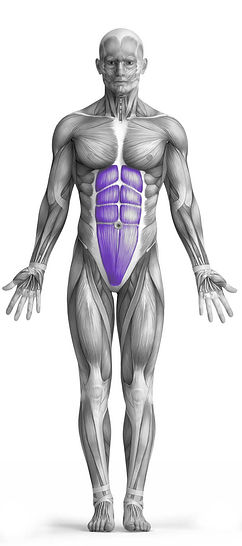Lying Cable Crunch 101 Video Tutorial
0

Exercise Synopsis
Target Muscle Group
Abs
Secondary Targets
None
Execution
Isolation
Force Type
Pull
Required Equipment
Cable Machine
Fitness Level
Beginner
Variations
None
Alternatives
None
Timer
Hour
Minute
Second
Stopwatch
00:00:00:00
Overview
The Lying Cable Crunch is an effective exercise targeting the abdominal muscles, specifically designed to strengthen and define the rectus abdominis. This movement isolates the abs without engaging secondary muscle groups, making it ideal for focused core development. Performed on a cable machine, it involves lying flat on your back while holding the cable attachment overhead and crunching your torso upward. The cable’s resistance adds constant tension, ensuring the abs remain activated throughout the range of motion. Proper form is essential to maximize effectiveness and avoid strain, requiring a controlled, deliberate motion and avoiding the use of momentum. This exercise is suitable for gym-goers looking to enhance their core strength and achieve greater abdominal definition.
How to Perform
Secure a rope attachment to the lowest setting on a cable machine. Lie on your back on the floor or a bench, positioning yourself in line with the pulley.
Grasp the ends of the rope firmly with both hands, positioning them near the sides of your head. Adjust your body so there is slight tension in the cable to engage the resistance from the start.
Keep your feet planted flat on the floor, knees bent at approximately 90 degrees. This is your starting position, ensuring your body is stable and ready for the movement.
Engage your core muscles and exhale as you contract your abs, curling your torso forward towards your knees. Keep the motion smooth and controlled, avoiding any jerking or pulling with your arms.
Maintain a steady grip on the rope and focus on using only your abdominal muscles to initiate the movement. Avoid letting your elbows move excessively; they should remain fixed near your head throughout the exercise.
Pause briefly at the peak of the crunch, ensuring your abs are fully contracted, and then slowly release the tension by returning to the starting position. Maintain control throughout the descent to keep the abs engaged.
Repeat for the desired number of repetitions, prioritizing form and technique over speed. Gradually increase the resistance or repetitions as your core strength improves.
★ Bonus: For exercises that involve external weights (such as dumbbells, barbells, or machines), the One Rep Max (1RM) calculator can help you estimate your maximum lifting capacity. Use it to track your strength progress and adjust your training for optimal results.
Tips
Perform the exercise with slow, deliberate movements. Ensure that each crunch is controlled to fully engage your abdominal muscles and reduce the risk of injury.
Focus on initiating the movement with your abs rather than using your arms to pull. Your arms should only assist in guiding the rope, not driving the motion.
Keep your spine neutral and avoid excessive arching of your back. Ensure that the movement stays within your torso to prevent unnecessary strain on your spine.
Do not use your hips or legs to assist with the crunch. Concentrate on flexing your spine through the contraction of your abdominal muscles.
Prioritize maintaining a steady and controlled pace, avoiding momentum, to maximize muscle activation and achieve better results.
How Not to Perform
Avoid Using Momentum: Do not jerk your body or swing to initiate the movement. This wastes energy and reduces the effectiveness of the exercise. Focus on using your core muscles to control the motion in a slow and deliberate manner.
Don’t Pull with Your Arms: Avoid using your arms to yank the rope. Your arms should remain relaxed, simply guiding the rope, while your abs do the work. This prevents unnecessary strain on the shoulders and helps maintain proper form.
Don’t Arch Your Back: Arching your back too much can lead to spinal discomfort and potential injury. Keep your back neutral throughout the exercise, ensuring the movement is isolated in your torso to protect your spine.
Don’t Engage Your Hips or Legs: Refrain from using your hips or legs to help with the crunch. Focus solely on contracting your abs and flexing your spine. Using your legs or hips shifts the emphasis away from your core and reduces the effectiveness of the exercise.
Avoid Rushing the Movement: Perform the crunch slowly, without rushing. A fast pace increases the risk of using momentum and reduces the time under tension for your abdominal muscles, diminishing the overall benefit of the exercise.
Don’t Overload the Weight: Using too much weight can cause you to lose control of the movement. Choose a resistance that allows you to perform the exercise with good form while still challenging your core muscles.
Don’t Let Your Elbows Move Excessively: Keep your elbows fixed in position and avoid allowing them to move too much. The motion should be controlled by your abs, not your arms, to prevent unnecessary strain and ensure proper muscle engagement.
Avoid Holding Your Breath: Don’t forget to breathe during the exercise. Holding your breath can increase intra-abdominal pressure and make the movement less efficient. Exhale as you crunch and inhale as you return to the starting position.
Don’t Let Your Lower Back Lift Off the Floor: Keep your lower back pressed against the floor or bench to prevent strain and ensure the movement stays focused on your abs. Lifting your lower back can cause unnecessary stress on your spine.
Variations
Variations of fitness exercises refer to different ways of performing a specific exercise or movement to target various muscle groups, intensities, or goals. These variations aim to challenge the body differently, prevent plateaus, and cater to individuals with varying fitness levels.
Alternatives
Alternative exercises in fitness refer to different movements or activities that target similar muscle groups or serve the same training purpose as the primary exercise. These alternative exercises can be used as substitutes when the original exercise is unavailable or challenging to perform due to various reasons such as equipment limitations, injuries, or personal preferences.








